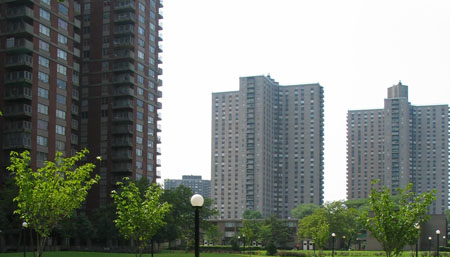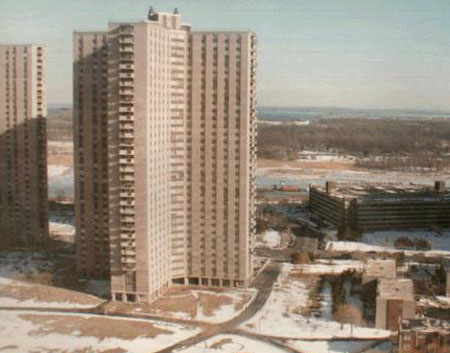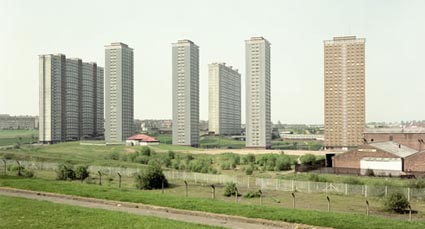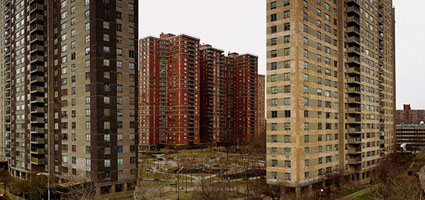
Dedicated to JASON BRIAN BARCLAY 5.21.1977-8.15.2006
Rest in peace young brother, Section 5 for life.
I spent a lot of time when I was young in the care of my grandparents, particularly my great-grandmother. To this day she is probably my single most powerful connection to GOD. If you have a grandmother and she loves you a lot then multiply that feeling exponentially. There isn’t a more developmentally encouraging person that I can think of for someone under 5 years of age.
The GOD reference was apropo too since my great-grandmother lived on the 25th floor of her apartment building and you couldn’t convice me otherwise that her apartment wasn’t Heaven. On a foggy overcast morning if you looked out the window you looked down on the clouds. They were so thick and cumulus that some kids thought they could ride them away. Unfortunately back then the city had no laws requiring child safety bars for hi-rise apartment building windows and every so often a mother’s anguished banshee wail would echo through the cavernous canyons of buildings. I guess you can’t have Heaven if there is no Hell.

My great-grandmother knew that she didn’t have to worry about me losing my sense of perspective even at that early age. She kept me busy with her cooked food, her card games and her love for mystery novels. She was an avid reader and I don’t even recall her watching anything on television, except when she let me watch Sesame Street. Her transistor radio in the kitchen was never turned off, but it was never too loud either. Just a calm sound that couldn’t replace the din of an energetic three year old. True story is that I don’t remember being three years old, but I remember my great-grandmother. I remember her voice and I remember her food.
My great-grandma was old school before I had even gone to school. Great-grandma was born on the island of Nevis in 1894 so by the time I touched down she had already seen the best and worst of all people. Her husband was a tall Irish-American immigrant, Mr.O’LOUGHLIN, who was renowned for threatening all the neighborhood rapscallions that might gaze for too long at any of his daughters or nieces. Mr.O’LOUGHLIN passed away when I was too young to have known him, but everyone that knows us will tell you that I have at least two of his traits. His eye for beautiful women and his oversized liver.
My great-grandmother certainly made up for any of Mr.O’LOUGHLIN’s lessons that might have been issued to me. Later in the day I would be joined by my grandmother and my grandfather. My grandmother was more or less the captain of the team that lived in Co-op City. They had all moved from my great-grandmother’s house in Queens to this brand new development in the Bronx.

Modeled after some technologically tremendous European residential architecture(pictured above), Co-op City was one of the largest housing initiatives ever created. The City housed almost sixty-thousand people in over 15,000 housing units. There were incredible amenities in this City within the city. Apartments were heated and cooled with centralized air conditioning. Each building had a multi-user laundromat. The ground floors of the apartment buildings hosted various medical offices for all the seniors that were part of the development. I think that was the appeal for my grandmother on behalf of my great-grandmother. The City’s site plan was so organized that you didn’t have to cross a street to get to the supermarket, the deli, the dry cleaners or the schools. This was from its inception a master plan that lent its design to utopian communism. Co-op City also had the greatest number of Black, Brown, Red, Yellow and white peoples living within the same zip code.
From the mind of a five year old child this was my favorite place on Earth, but under the surface of this faux forced utopia were the undercurrents of social unraveling on a grand scale. Co-op City for all of its charm and extravagance could not escape the real world right across the street. The Bronx is the poorest section of America per capita and Co-op City would not be exempted. In order for the developers of Co-op City to secure the Federal H.U.D. money to create the development there had to housing set aside for people receiving Federal and state income supplements. The developers designed the city so that this area where their ‘Section 8’ tenants would reside was separated from the primary housing block. They were provided with their own shopping cluster and primary grade schools, but the high school students would be required to travel by public bus. The area of Co-op City that housed primarily all of the developments welfare recipients was further sequestered from the larger complex by being on the opposite side of the Hutchinson River. Occasionally, the drawbridge that you had to cross to enter that section would be raised if there was a barge traveling up the river.
There was certainly a distinction made between the residents of Section 5 and the rest of the Co-op City residents in Sections 1-4 (no relation to ‘Section 8’). These differences would manifest themelves at the local high school, HARRY S. TRUMAN, where children from middle class aspiring parents comingled with the children of parent(s) who may not have shared those same values. I believe this was the failure of Co-op City and the subsequent failure of residential communities of even smaller scales. A community’s value system will be reflected by it’s most mediocre denizens, where those that have a higher value system will displace themselves or be shunted altogether. High rise apartment complexes work in European cities because they are occupied by residents who share the same class value system. There won’t be any pissing in the hallways in Glasglow, not because they are more civilized, but because that is never projected as an option to using the bathroom.

The residents in Co-op City began to reflect the values of people that feel like they have no stake in the place that they reside. Simple issues like litter can become tremendous issues when you contemplate the magnitude of 60,000 people all living within the same 300 acres. Trust me, there’s no longer any room to breathe. Co-op City barely made it through New York City’s fiscal crisis during the 1970’s. City services like mass transit and garbage collection were severely halted. Roadway repair was also non-existant and this was an area of the Bronx that residents needed to drive to and from their jobs if they had one. Now try to imagine the resulting clamor when the mid-1980’s recession and drug explosion took hold of the city. This much ballyhooed model community was under siege. The last remaining white residents fled from Co-op City as if it were the Titanic sinking in the middle of the ocean.
The diversity that began when this city first opened its doors was no more. It was now metamorphisized into the largest Federal housing project in the country. More reflective of the southern Bronx neighborhoods like SoundView and Hunts Point as opposed to the diverse middle class western Bronx enclaves like Marble Hill and Riverdale. Co-op City is a great study in urban design and planning, but I think it serves as a better example for socio-economic trends. This is why many whites are opposed to sharing zip codes with different peoples. If the vales of new residents doesn’t at least meet those of the incumbent community you will have a loss of property value. Transversely, if new residents into a community value their property they will be able to displace the incumbent community who does not have those values.
So now when I look at high rise apartment buildings I see them as just ‘Reservations in the Sky’. Instead of giving away multi-acre tracts of land for people to establish their communities the government is stacking houses on top of one another so much like LEGO blocks.
You are on a roll this week. Another good one.
Wow, good posts. The only time I’ve ever seen high rise complexes such as the one in your city was in Chicago. When I was kid, we drove to our vacation destinations most of the time and we always went through Chicago so I’d always look for the high rise. It stood right off of the Kennedy Expressway (just minutes from the skyline). It was bulldozed down about 6 years or so. I imagine at some point (years and years ago)that it wasn’t such a bad place to live….
Our hi-rises were usually places for old folks or projects. Neither were places you really wanted to be.
“Modeled after some technologically tremendous European residential architecture(pictured above)”
It’s no small irony that France would use this model to build public housing tenements to host the wave of African and Arab immigrants that arrived in the 70’s only to end up in the exact same situation. The results were unemployed youth on park benches and street corners and hopeless families unable to move out of what became isolated ghettos (in every sense of the word) on the outer rim of the city far from the pristine Tourist attractions.
I’m loving the best of week.